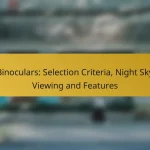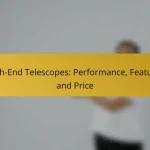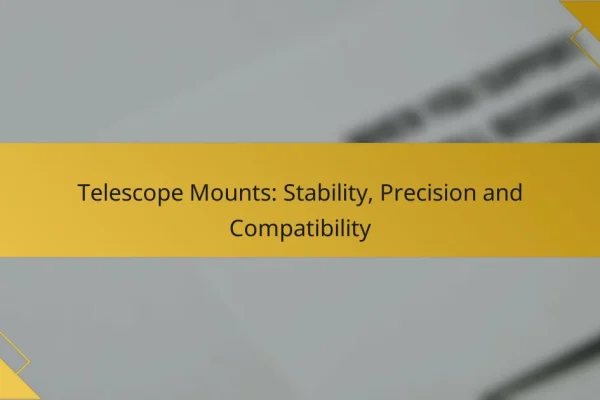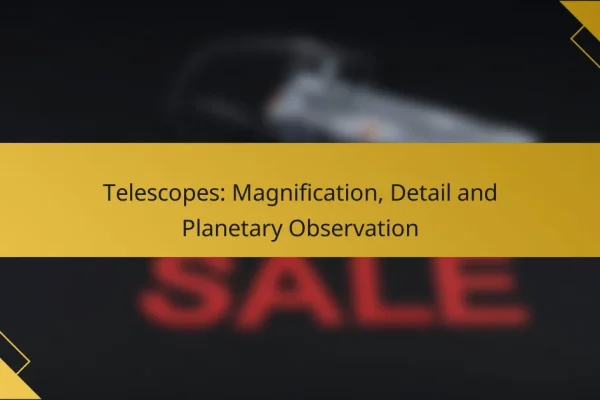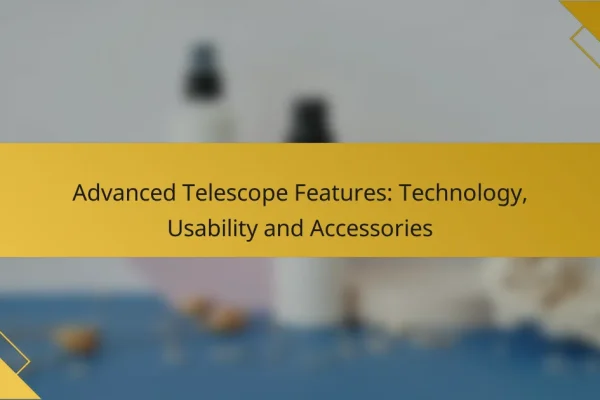What are the best advanced telescopes for serious astronomers?
The best advanced telescopes for serious astronomers combine high-quality optics, advanced features, and user-friendly design. Top models like the Celestron EdgeHD 1100 and Meade LX600 offer exceptional performance for deep-sky observations and astrophotography.
Celestron EdgeHD 1100
The Celestron EdgeHD 1100 is renowned for its sharp, flat-field optics, making it ideal for both visual astronomy and imaging. Its advanced optical design minimizes aberrations, providing clear views of celestial objects.
This telescope features a 280mm aperture, allowing for impressive light-gathering capabilities. It is compatible with various accessories, including focal reducers and advanced mounts, enhancing its versatility for serious astronomers.
Meade LX600
The Meade LX600 is a sophisticated telescope that integrates advanced technology with user-friendly features. Its ACF optics deliver excellent image quality, particularly for astrophotography, with minimal distortion across the field of view.
Equipped with a GPS system and automated alignment, the LX600 simplifies setup, making it accessible for users at various experience levels. The telescope’s robust construction ensures durability, making it suitable for both home observatories and field use.
Sky-Watcher Esprit 120
The Sky-Watcher Esprit 120 is a premium refractor telescope designed for serious astrophotographers. Its triplet lens design provides exceptional color correction and sharpness, ideal for capturing detailed images of planets and deep-sky objects.
This telescope features a 120mm aperture and a focal length of 840mm, making it versatile for various types of celestial observations. Its lightweight design allows for easy transport, while its solid build ensures stability during use.
Orion 10020
The Orion 10020 is a high-performance reflector telescope that offers excellent value for serious astronomers. With a 10-inch aperture, it provides bright and detailed views of both planetary and deep-sky objects.
This telescope is designed for ease of use, featuring a sturdy mount and intuitive controls. Its large aperture allows for impressive light-gathering, making it suitable for observing faint galaxies and nebulae.
Takashi FSQ-106
The Takashi FSQ-106 is a top-tier refractor telescope known for its exceptional optical quality and compact design. Its 106mm aperture and fast focal ratio make it a favorite among astrophotographers seeking high-resolution images.
This telescope’s lightweight construction and superior build quality make it easy to transport and set up. Its compatibility with various mounts and accessories enhances its usability for both visual and photographic applications.
How do advanced telescopes enhance astronomical observation?
Advanced telescopes significantly enhance astronomical observation by improving light-gathering capability, increasing image resolution, and incorporating sophisticated tracking systems. These features allow astronomers to observe celestial objects with greater clarity and detail, facilitating deeper exploration of the universe.
Improved light-gathering capability
Advanced telescopes are designed with larger apertures, which enable them to collect more light from distant celestial objects. This increased light-gathering capability allows astronomers to observe fainter stars and galaxies that would be invisible to smaller telescopes.
For example, a telescope with an aperture of 10 inches can gather up to four times more light than one with a 5-inch aperture. This difference can dramatically enhance the visibility of nebulae and other faint phenomena in the night sky.
Higher resolution images
Higher resolution images are a hallmark of advanced telescopes, achieved through improved optics and larger apertures. These telescopes can resolve finer details, allowing astronomers to distinguish between closely spaced objects and observe surface features on planets and moons.
For instance, a telescope with a resolution of 0.5 arcseconds can reveal details on the surface of Mars, such as polar ice caps and dust storms, which would be blurred in lower-resolution images. This capability is crucial for detailed studies of planetary atmospheres and surface conditions.
Advanced tracking systems
Advanced telescopes often include sophisticated tracking systems that compensate for the Earth’s rotation, allowing for prolonged observation of celestial objects without losing them from view. These systems can be automated and are essential for deep-sky imaging and spectroscopy.
Many modern telescopes utilize computer-controlled mounts that can track objects with high precision. This feature is particularly beneficial for astrophotography, where long exposure times are required to capture detailed images of faint objects without motion blur.
What features should serious astronomers consider when choosing a telescope?
Serious astronomers should prioritize features such as aperture size, mount type, optical design, and portability when selecting a telescope. These elements significantly impact the telescope’s performance, usability, and suitability for various astronomical observations.
Aperture size
Aperture size is crucial as it determines the amount of light the telescope can gather, affecting image brightness and clarity. For serious astronomers, an aperture of at least 4 inches (100 mm) is recommended for deep-sky observations, while larger apertures, like 8 inches (200 mm) or more, are ideal for detailed planetary viewing.
Keep in mind that larger apertures can lead to heavier and bulkier telescopes, which may affect portability. Balancing the need for light-gathering capability with practical considerations is essential.
Mount type
The mount type influences stability and ease of use. There are two primary types: altazimuth and equatorial mounts. Altazimuth mounts are user-friendly and suitable for beginners, while equatorial mounts allow for precise tracking of celestial objects, making them preferable for serious astronomers.
Consider the weight of the telescope and the mount’s load capacity. A sturdy mount can enhance the viewing experience by minimizing vibrations and ensuring smooth tracking during observations.
Optical design
Optical design affects image quality and the types of celestial objects you can observe. Common designs include refractors, reflectors, and compound telescopes. Refractors offer sharp images and are great for planetary viewing, while reflectors provide larger apertures at lower costs, making them suitable for deep-sky observations.
Choose an optical design that aligns with your primary interests in astronomy. Each design has its strengths and weaknesses, so understanding these can help you make an informed decision.
Portability
Portability is essential for astronomers who wish to travel to dark-sky locations. A lightweight and compact telescope is easier to transport, but this often comes at the cost of aperture size and stability. Consider how often you plan to move your telescope when making your choice.
For those who frequently observe in various locations, a telescope that can be easily disassembled or has a compact design will enhance your experience. Look for models that balance portability with performance to suit your observing habits.
What are the pricing ranges for advanced telescopes?
Advanced telescopes typically range in price from a few hundred to several thousand dollars, depending on their features and capabilities. Serious astronomers should consider their specific needs, such as portability, optical quality, and mount type, when selecting a telescope within these ranges.
Entry-level options under $1,000
Entry-level telescopes priced under $1,000 are ideal for beginners and casual stargazers. These models often feature smaller apertures and simpler mounts, making them easier to transport and set up.
Popular choices in this category include refractors and small reflectors, which can provide decent views of the moon and planets. Look for models with good optics and sturdy construction to ensure a satisfying experience.
Mid-range options between $1,000 and $3,000
Mid-range telescopes, priced between $1,000 and $3,000, offer enhanced features and better optical performance. These telescopes often come with larger apertures and more advanced mounts, allowing for deeper sky observations.
In this range, you can find high-quality Schmidt-Cassegrain and larger reflector telescopes. These models are suitable for both visual astronomy and astrophotography, providing a good balance of performance and affordability.
High-end options over $3,000
High-end telescopes priced over $3,000 cater to serious astronomers and professionals seeking top-tier performance. These telescopes typically feature large apertures, advanced optics, and sophisticated mounts that support heavy equipment.
Examples include premium refractors and large aperture reflectors, which excel in both visual and photographic applications. Investing in these models ensures exceptional image quality and durability, making them suitable for long-term use in various observing conditions.
What are the best accessories for advanced telescopes?
The best accessories for advanced telescopes enhance viewing experiences and improve overall performance. Key accessories include high-quality eyepieces, filters, and mounts, each contributing to more detailed observations and ease of use.
High-quality eyepieces
High-quality eyepieces are essential for maximizing the capabilities of advanced telescopes. They determine the clarity and detail of the images you see, with better eyepieces offering wider fields of view and improved color fidelity.
When selecting eyepieces, consider focal length and design. Shorter focal lengths provide higher magnification, while longer ones yield wider views. Popular designs include Plössl, Nagler, and Orthoscopic, each with unique advantages depending on your observing needs.
To avoid common pitfalls, invest in a few versatile eyepieces rather than a large collection. A good starting set might include a low-power eyepiece (around 25mm), a medium-power option (10-15mm), and a high-power eyepiece (5-7mm) for detailed observations of planets and deep-sky objects.

